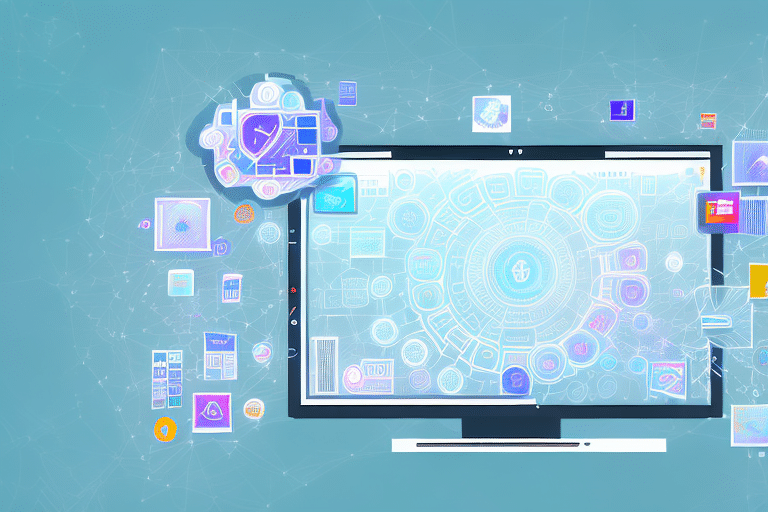In the rapidly evolving landscape of work, employee productivity has become a focal point for organizations aiming to maintain competitiveness and foster innovation. One technology that has emerged as a game changer in enhancing productivity is the virtual desktop. This article explores the concept of virtual desktops, their role in today’s work environment, their impact on productivity, the challenges they present, and their future in the corporate sphere.
Understanding the Concept of Virtual Desktops
Defining Virtual Desktops
Virtual desktops refer to a desktop environment that is hosted on a remote server rather than being tied to an individual physical machine. Users can access their desktops from any device, anywhere, as long as they have an internet connection. This allows for a seamless user experience, where the desktop appears to have all the functionalities and applications of a traditional desktop, effectively decoupling the software from the hardware limitations.
This technology leverages virtualization to create and manage multiple desktop instances on a centralized server. Employees are provided with a consistent and familiar interface that can be tailored to meet specific needs, which enhances their ability to perform tasks efficiently. From a management perspective, it enables IT departments to maintain more control over the software and security settings across all devices. Additionally, virtual desktops can significantly reduce the costs associated with hardware upgrades, as the processing power is centralized and can be scaled according to the organization’s needs. This flexibility not only saves money but also allows businesses to allocate resources more effectively, ensuring that employees have access to the tools they need without unnecessary delays.
The Evolution of Virtual Desktops
The evolution of virtual desktops traces back to the advancements in cloud computing and virtualization technologies. Initially, organizations relied on physical desktops that limited employee flexibility. However, as businesses began to embrace remote work, the demand for alternative solutions increased.
The introduction of Virtual Desktop Infrastructure (VDI) marked a significant milestone. It allows multiple users to access desktop environments on a single server. As internet speeds improved and cloud services became more reliable, the concept expanded to include Desktop as a Service (DaaS), where third-party cloud providers offer virtual desktops on a subscription basis. This evolution has paved the way for a more agile and versatile work environment. Furthermore, the integration of advanced security protocols and encryption technologies has made virtual desktops a viable option for industries that handle sensitive data, such as finance and healthcare. Organizations can now ensure that their data remains secure while still providing employees with the flexibility to work from various locations. This balance of security and accessibility is crucial in today’s fast-paced business landscape, where remote work is becoming the norm rather than the exception.
The Role of Virtual Desktops in Today’s Work Environment
The Shift to Remote Work
The COVID-19 pandemic drastically accelerated the adoption of remote work models, prompting companies to rethink their operational strategies. Virtual desktops have played a pivotal role in facilitating this shift by enabling employees to access their work environments from home or on-the-go without compromising on functionality or security.
Employers quickly realized that virtual desktops reduced the dependency on physical office spaces while still allowing teams to collaborate effectively. This flexibility not only bolstered productivity but also improved employee morale, as individuals could work in environments that suited their personal needs. Furthermore, the ability to access corporate resources securely from any location has made it easier for businesses to attract and retain talent, as employees now prioritize flexibility and work-life balance more than ever before.
The Demand for Flexible Work Solutions
As remote work becomes a standard practice, the demand for flexible work solutions is greater than ever. Organizations are recognizing the importance of offering employees the tools they need to work effectively, regardless of their location. Virtual desktops provide an immediate solution to this demand by creating a work experience that is not limited to a single device or location.
This flexibility extends beyond just remote work; it allows employees to shift between devices seamlessly. Whether transitioning from a laptop at home to a tablet while traveling, users maintain a consistent experience, which translates to uninterrupted productivity. Moreover, businesses can scale up or down according to workforce needs without the need for significant hardware investments. The rise of virtual desktops also encourages a more sustainable approach to IT infrastructure, as companies can reduce their carbon footprint by minimizing the physical hardware required and optimizing energy consumption through centralized data centers.
Additionally, the integration of virtual desktops with cloud services has opened up new avenues for collaboration and innovation. Teams can work on shared projects in real-time, utilizing powerful applications that may have been previously restricted to on-premises setups. This collaborative environment fosters creativity and accelerates project timelines, as employees can contribute from anywhere in the world, breaking down geographical barriers that once hindered teamwork. As organizations continue to adapt to the evolving landscape of work, the role of virtual desktops will likely expand, offering even more advanced features that cater to the dynamic needs of the modern workforce.
The Impact of Virtual Desktops on Employee Productivity
Improved Accessibility and Flexibility
One of the most significant benefits of virtual desktops is their ability to enhance accessibility. Employees can access their desktops from almost any internet-enabled device, allowing them to work from various environments, including home, coffee shops, or coworking spaces. This mobility contributes to higher productivity levels, as employees can choose to work where they feel most comfortable and focused.
Furthermore, with all essential applications and files hosted in one place, employees save time that would otherwise be spent retrieving or transferring data between devices. The convenience of accessing a fully operational desktop within seconds empowers employees to hit the ground running and focus on their tasks without unnecessary distractions. This flexibility not only caters to individual work styles but also accommodates diverse schedules, enabling employees to work during their most productive hours, whether that be early in the morning or late at night.
Additionally, the ability to seamlessly switch between devices means that employees can maintain productivity even when unexpected situations arise, such as travel delays or family commitments. The peace of mind that comes from knowing they can access their work from anywhere helps reduce stress and increases overall job satisfaction, which can lead to lower turnover rates and a more engaged workforce.
Enhanced Collaboration and Communication
Virtual desktops also foster better collaboration among team members. Many virtual desktop solutions come equipped with integrated collaboration tools that enable real-time communication and file sharing. This capability is crucial in breaking down geographical barriers, allowing teams spread across different locations to work together as if they were in the same room.
Moreover, virtual desktops often support communication platforms that keep teams connected. These systems not only streamline project management but also ensure that everyone is on the same page regarding updates and responsibilities, further enhancing productivity across teams. The ability to share screens, conduct virtual meetings, and collaborate on documents in real-time eliminates the friction often associated with traditional workflows, enabling teams to respond to challenges and opportunities more swiftly.
In addition, the integration of project management tools within virtual desktop environments allows for better tracking of tasks and deadlines. Employees can easily assign responsibilities, monitor progress, and provide feedback, creating a more transparent and accountable work culture. This enhanced visibility into team dynamics fosters a sense of camaraderie and shared purpose, ultimately driving collective productivity and innovation. As teams become more cohesive, they are better equipped to tackle complex projects and adapt to changing business needs, further solidifying the role of virtual desktops in modern work environments.
Overcoming Challenges with Virtual Desktops
Addressing Security Concerns
While the advantages of virtual desktops are clear, organizations must also navigate several challenges, particularly concerning security. Storing sensitive data on a centralized server can pose risks if not managed correctly. Cyberattacks that target these servers can lead to data breaches and the loss of critical information.
To mitigate these risks, organizations must invest in robust security measures, including encryption, multi-factor authentication, and continuous monitoring. Additionally, educating employees on best practices for data security—such as recognizing phishing attempts and using secure connections—can further protect the organization’s digital assets. Regular security audits and vulnerability assessments are also essential, as they help identify potential weaknesses in the system before they can be exploited. Furthermore, implementing a zero-trust security model can enhance protection by ensuring that every access request is thoroughly verified, regardless of the user’s location.
Ensuring Reliable Connectivity
The reliance on internet connectivity is another challenge associated with virtual desktops. Employees need stable, high-speed internet access to work efficiently. Poor connectivity can lead to frustrations, stalled projects, and decreased productivity.
To address this issue, organizations can provide support to employees by offering stipends for better internet plans or utilizing caching solutions that allow for offline access to crucial applications. This way, teams can remain productive even when connectivity issues arise, ensuring that workflows are not interrupted. Additionally, organizations might consider implementing a hybrid model that combines virtual desktops with local applications, allowing employees to switch seamlessly between online and offline work environments. Investing in network redundancy solutions can also enhance reliability, ensuring that if one connection fails, another can take over without disrupting the user’s experience. By proactively addressing connectivity challenges, companies can foster a more resilient and adaptable workforce.
Future of Work: Virtual Desktops and Beyond
Predicted Trends in Virtual Desktop Technology
As we look toward the future, several trends in virtual desktop technology are set to shape the work landscape. One significant prediction is the continued integration of artificial intelligence (AI) to improve user support and customization. AI-driven analytics can help determine usage patterns and optimize resources, further enhancing efficiency. This means that virtual desktops will not only become more responsive to individual user needs but will also learn and adapt over time, creating a more personalized experience that can boost productivity and satisfaction.
Moreover, as cloud computing continues to evolve, we can expect advancements that make virtual desktops more intuitive and user-friendly. These technologies may also enable more robust security features that are seamlessly integrated into everyday workflows, adopting a proactive rather than reactive stance on data protection. For instance, biometric authentication and advanced encryption methods are likely to become standard, ensuring that sensitive information remains secure without compromising user convenience. Additionally, the rise of edge computing could further enhance performance by processing data closer to the user, reducing latency and improving overall responsiveness.
Preparing for a Virtual-First Work Environment
Organizations looking to thrive in a future dominated by remote work and virtual desktops should start preparing for a virtual-first environment now. This preparation involves investing not only in the technology itself but also in training employees to leverage these tools effectively. Training programs that focus on digital literacy and remote collaboration skills will be essential, as they empower employees to navigate the complexities of virtual environments with confidence and ease.
Establishing clear policies and best practices for remote work will be crucial. Organizations should focus on creating a culture that embraces flexibility and recognizes the importance of maintaining employee engagement and well-being, even in a virtual setting. This includes implementing regular check-ins, virtual team-building activities, and mental health resources to support employees in their remote work journeys. With thoughtful implementation, virtual desktops can serve as the backbone for enhanced productivity in the new world of work, fostering a sense of community and collaboration that transcends physical boundaries. As organizations adapt to these changes, they will likely discover innovative ways to harness the full potential of technology, paving the way for a more connected and efficient workforce.


